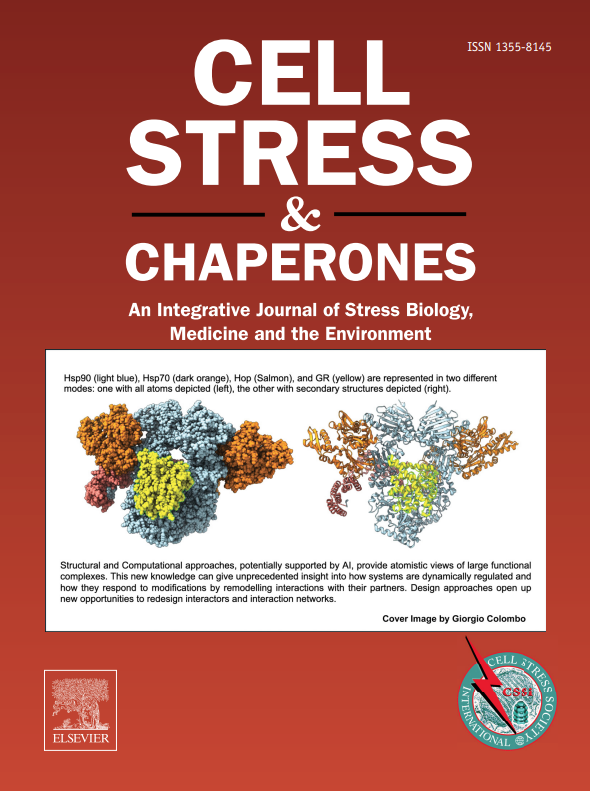剧烈运动 59 分钟后,唾液细胞外热休克蛋白 70 (eHSP70) 水平升高,并与静息时唾液分泌型免疫球蛋白 A (SIgA) 水平相关。
IF 3.3
3区 生物学
Q3 CELL BIOLOGY
引用次数: 0
摘要
本研究旨在确定唾液应激蛋白--细胞外热休克蛋白(eHSP70)对剧烈运动的反应,并探讨唾液eHSP70和唾液免疫球蛋白A(SIgA)水平对运动反应的关系。16 名健康的久坐青年男性(平均值 ± SD 23.8 ± 1.5 岁,172.2 ± 6.4 厘米,68.3 ± 7.4 千克)以 75% VO2max 的速度进行了 59 分钟的自行车运动。分别在运动前(Pre)、运动后(Post)和运动结束后 1、2、3 和 4 小时(1、2、3 和 4 小时)采集唾液和全血样本。唾液中的 eHSP70 和 SIgA 含量由酶联免疫吸附试验(ELISA)测定,分泌率则由浓度乘以唾液流速计算得出。白细胞用带有直流检测系统的自动细胞计数器进行分析。实验前、实验后和实验后 1、2、3 和 4 h 的唾液 eHSP70 分泌率分别为 1.11 ± 0.86、1.51 ± 1.47、1.57 ± 1.32、2.21 ± 2.04、3.36 ± 2.72 和 6.89 ± 4.02 ng - min(-1)。唾液中 eHSP70 的分泌率在 4 h 时明显高于前、后、1 和 3 h 时(p < 0.05)。前、后、1、2、3 和 4 h 的唾液 SIgA 分泌率分别为 26.9 ± 12.6、20.3 ± 10.4、19.6 ± 11.0、21.8 ± 12.8、21.5 ± 11.9 和 21.9 ± 11.7 μg - min(-1)。1 至 4 h 的唾液 SIgA 分泌率明显低于前期(p < 0.05)。运动前唾液中 eHSP70 和 SIgA 的浓度和分泌率均呈正相关(p < 0.05)。运动后白细胞的绝对数量明显增加,2 小时后达到最大值(p < 0.05)。与运动前样本相比,中性粒细胞/淋巴细胞比率在 1 至 4 小时内明显增加(p < 0.05)。本研究表明,久坐不动的男性受试者在进行 59 分钟的剧烈运动后 4 小时,唾液中的 eHSP70 明显升高。运动应激可诱导唾液eHSP70水平升高,并部分上调口腔免疫功能。本文章由计算机程序翻译,如有差异,请以英文原文为准。
Salivary extracellular heat shock protein 70 (eHSP70) levels increase after 59 min of intense exercise and correlate with resting salivary secretory immunoglobulin A (SIgA) levels at rest
This study aimed to identify the response of a salivary stress protein, extracellular heat shock protein (eHSP70), to intense exercise and to investigate the relationship between salivary eHSP70 and salivary immunoglobulin A (SIgA) levels in response to exercise. Sixteen healthy sedentary young males (means ± SD 23.8 ± 1.5 years, 172.2 ± 6.4 cm, 68.3 ± 7.4 kg) performed 59 min of cycling exercise at 75 % VO2max. Saliva and whole blood samples were collected before (Pre), immediately after (Post), and at 1, 2, 3, and 4 h after completion of the exercise (1, 2, 3, and 4 h). The salivary eHSP70 and SIgA levels were measured by enzyme-linked imunosorbent assay (ELISA), and the secretion rates were computed by multiplying the concentration by the saliva flow rate. White blood cells were analyzed using an automated cell counter with a direct-current detection system. The salivary eHSP70 secretion rates were 1.11 ± 0.86, 1.51 ± 1.47, 1.57 ± 1.32, 2.21 ± 2.04, 3.36 ± 2.72, and 6.89 ± 4.02 ng · min−1 at Pre, Post, and 1, 2, 3, and 4 h, respectively. The salivary eHSP70 secretion rate was significantly higher at 4 h than that at Pre, Post, 1, and 3 h (p < 0.05). The SIgA secretion rates were 26.9 ± 12.6, 20.3 ± 10.4, 19.6 ± 11.0, 21.8 ± 12.8, 21.5 ± 11.9, and 21.9 ± 11.7 μg · min−1 at Pre, Post, 1, 2, 3, and 4 h, respectively. The salivary SIgA secretion rate was significantly lower between 1 and 4 h than that at Pre (p < 0.05). There was a positive correlation between salivary eHSP70 and SIgA in both concentration and secretion rates before exercise (p < 0.05). The absolute number of white blood cells significantly increased after exercise, with a maximum at 2 h (p < 0.05). The neutrophil/lymphocyte ratio was significantly increased from 1 to 4 h when compared with that in the Pre samples (p < 0.05). The present study revealed that salivary eHSP70 significantly increased at 4 h after the 59 min of intense exercise in sedentary male subjects. Exercise stress can induce elevated salivary eHSP70 level and upregulate oral immune function partially.
求助全文
通过发布文献求助,成功后即可免费获取论文全文。
去求助
来源期刊

Cell Stress & Chaperones
生物-细胞生物学
CiteScore
7.60
自引率
2.60%
发文量
59
审稿时长
6-12 weeks
期刊介绍:
Cell Stress and Chaperones is an integrative journal that bridges the gap between laboratory model systems and natural populations. The journal captures the eclectic spirit of the cellular stress response field in a single, concentrated source of current information. Major emphasis is placed on the effects of climate change on individual species in the natural environment and their capacity to adapt. This emphasis expands our focus on stress biology and medicine by linking climate change effects to research on cellular stress responses of animals, micro-organisms and plants.
 求助内容:
求助内容: 应助结果提醒方式:
应助结果提醒方式:


